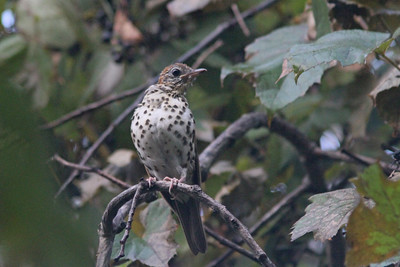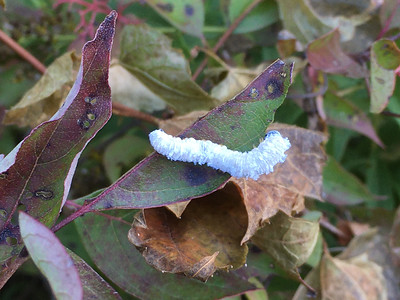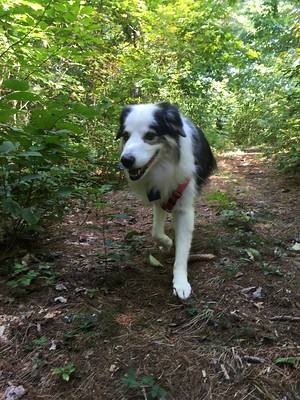Today was another warmer than normal day but yet another morning of low clouds and occasional drizzle which made photography a bit difficult. Nonetheless it was a decent morning of birding at Arcadia with a few notables including a late Least Flycatcher and a couple of late Yellow Warblers plus a likely Connecticut Warbler (the view was too brief to be a 100% certain). Overall the numbers and diversity of sparrows and warblers was down a bit from a couple days before but Lincoln's Sparrows continue to show in good numbers.
I didn't have a lot of time in the morning on Saturday so I stayed close to home with visits to Quabbin Park and a nearby spot on Ware. I tried to find a lingering Eastern Whip Poor Will before dawn but had no luck...they all appear to have finally migrated south. I covered just a small portion of the park in the early morning gloom of fog and drizzle and the Red breasted Nuthatch numbers continue to impress. Nothing too noteworthy as far as birds go beyond a nice selection of thrushes early on. I did get to see a family of River Otters up close with one happily munching on a fish, which is always fun.
Arcadia was my stop on Thursday morning with my main focus being finding a Connecticut Warbler and after a lot of effort I managed a fleeting view (only my second sighting of the species so far this fall which is way below average by this date)...sadly no chance for a photo. The morning was quite productive and turned up species such as two flyby Pine Siskins (hopefully the beginning of an influx of the species), a very early Snow Bunting (perhaps brought in after days and days of northerly winds), half a dozen species of sparrows, at least nine Tennessee Warblers, four Yellow Warblers (getting late for the species), a few Scarlet Tanagers and a Dickcissel.
On the 23rd I started another frosty morning at Silvio Conte NWR-Fort River. Nothing too unexpected to report from that stop and overall it was a bit slow but still well worth the visit with half a dozen Wood Thrushes, a dozen flyby Purple Finches and five Tennessee Warblers among eleven species of warblers. I then left there with the intention to hit the Honey Pot but when I arrived there the previously productive fields (as far as shorebirds go) where in the midst of being plowed under so I continued north with a stop along a right of way down to the river. What was intended to be a short stop turned into an hour plus of looking around after I stumbled across a Yellow breasted Chat. I searched for it for over thirty minutes after the initial sighting and never saw it again (amazing how stealthy chats around here can be compared to how obvious and loud they are in other parts of their range).
After getting out of work on Tuesday morning I headed right down to Arcadia where I spent a couple hours poking around the meadows. Among the many highlights were continued numbers of flyover Purple Finches (quite an influx lately), a Clay colored Sparrow, my first Dark eyed Juncos and American Pipit of the fall, lots of other sparrows, a dozen Tennessee Warblers, a noticeable increase in Yellow rumped Warblers and at least 18 Indigo Buntings.
Last Sunday I started off at UMASS and then headed down to Silvio Conte NWR-Fort River. UMASS was a little slow but still produced a whinnying Eastern Screech Owl, some obvious Blue Jay migration, a couple Philadelphia Vireos and several thrushes of various species early on. Conte was a little more active as the morning warmed up and I turned up 15 species of warblers including a Mourning Warbler and four Cape May Warblers. I also came across a few banded birds and managed to get photos of one (an Eastern Phoebe).
The new water feature that I installed last week didn't have too many visitors in the first several days but on Saturday that all changed with nine species showing up. The first species I captured was on the 21st when a Black capped Chickadee stopped in briefly. I have been trying to come up with the best location for the camera to capture as many birds as possible but not get a ton of non bird shots caused by the cascading water.
Another notable sighting around the house occurred today when I found two banded Black capped Chickadees in a mixed flock around the house. Both of the birds were banded in 2019 and I had them around all winter and into the spring but had not seen them in several weeks.
The tropics look to finally be quieting down (at least for a few days) with no new areas of development expected in the next five days per the NHC. Hurricane Teddy hit the eastern end of Nova Scotia on Wednesday before continuing off to the northeast and into Newfoundland. It will be interesting to see what unusual species turn up in Canada during and after the storm. More on the storm can be found at the following link from BirdCast. Despite the current lull in tropical activity there is still a lot of tropical season left and there is certainly the chance of more storms to come into October and possibly beyond.





























No comments:
Post a Comment